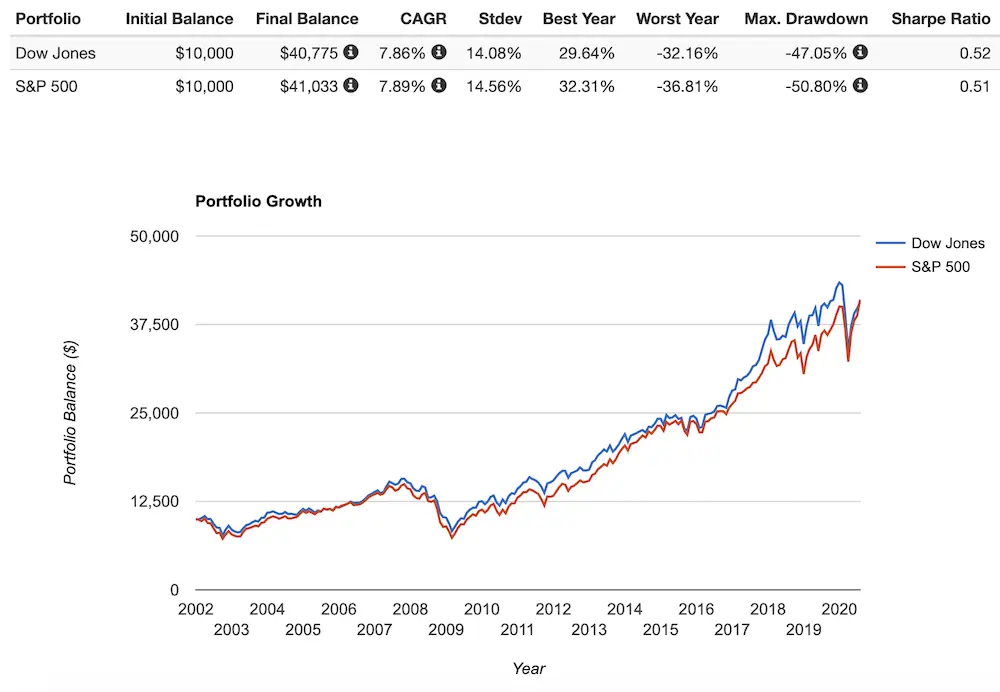The Dow Jones Industrial Average, usually called the “Dow Jones index” or simply “the Dow,” is comprised of 30 large companies in the U.S. Here we'll look at how to invest in the Dow Jones index with a single ETF.
Disclosure: Some of the links on this page are referral links. At no additional cost to you, if you choose to make a purchase or sign up for a service after clicking through those links, I may receive a small commission. This allows me to continue producing high-quality, ad-free content on this site and pays for the occasional cup of coffee. I have first-hand experience with every product or service I recommend, and I recommend them because I genuinely believe they are useful, not because of the commission I get if you decide to purchase through my links. Read more here.
Introduction
The Dow Jones index was created in 1896, making it one of the oldest stock indexes. It is named after its co-creators Charles Dow and Edward Jones. The Dow is criticized for being an inaccurate representation of the U.S. stock market given that it is not market cap weighted and only contains 30 companies. That said, with it possessing 30 of the largest companies in the U.S. stock market, it should be less volatile than other indexes like the S&P 500 and the Russell 3000, which is how it has played out since 2002:

At its inception, the Dow Jones Industrial Average, as the name suggests, entirely contained companies involved in heavy industry. That has since obviously changed. Nowadays, the Dow represents a variety of sectors across the U.S. stock market.
Investors can invest in the Dow using the one and only ETF (Exchange Traded Fund) that accurately tracks the index: the Dow Jones® Industrial Average ETF Trust from SPDR, for which the ticker symbol is DIA. The fund carries an expense ratio of 0.16%.
DIA is available on M1 Finance. The online broker has zero transaction fees and offers fractional shares, dynamic rebalancing, and a modern, user-friendly interface and mobile app. I wrote a comprehensive review of M1 Finance here.
Disclosures: None.
Interested in more Lazy Portfolios? See the full list here.
Disclaimer: While I love diving into investing-related data and playing around with backtests, this is not financial advice, investing advice, or tax advice. The information on this website is for informational, educational, and entertainment purposes only. Investment products discussed (ETFs, mutual funds, etc.) are for illustrative purposes only. It is not a recommendation to buy, sell, or otherwise transact in any of the products mentioned. I always attempt to ensure the accuracy of information presented but that accuracy cannot be guaranteed. Do your own due diligence. I mention M1 Finance a lot around here. M1 does not provide investment advice, and this is not an offer or solicitation of an offer, or advice to buy or sell any security, and you are encouraged to consult your personal investment, legal, and tax advisors. All examples above are hypothetical, do not reflect any specific investments, are for informational purposes only, and should not be considered an offer to buy or sell any products. All investing involves risk, including the risk of losing the money you invest. Past performance does not guarantee future results. Opinions are my own and do not represent those of other parties mentioned. Read my lengthier disclaimer here.

Are you nearing or in retirement? Use my link here to get a free holistic financial plan from fiduciary advisors at Retirable to manage your savings, spend smarter, and navigate key decisions.
Don't want to do all this investing stuff yourself or feel overwhelmed? Check out my flat-fee-only fiduciary friends over at Advisor.com.

Leave a Reply